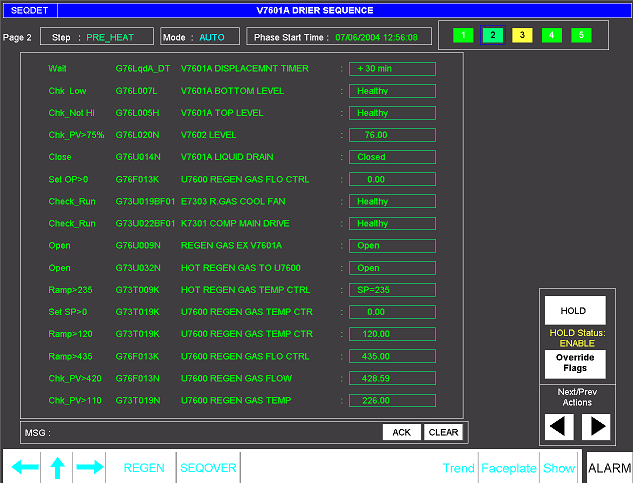Sequence Framework
The Process IT Sequence Framework is a field-proven library of graphics and CL code
that allows complex sequencing tasks to be efficiently implemented on Honeywell TDC3000
and TPS systems.
Features
- Provides a flexible and powerful framework for sequence-oriented tasks
- Designed with parallel sequence operation in mind
- Allows up to 240 steps per sequence, and supports back-branching and loops
- Includes Abnormal Condition Handling (ACHs) as standard functionality
- Allows for integration with various forms of recipes and recipe management schemes
Parallel Sequencing
Support for parallel sequencing was one of the main design criteria for the Sequence Framework.
The framework consists of a main sequence which performs the overall scheduling activities, and
controls a number of subordinate sequences. The subordinates can be started and stopped by the main sequence,
and also report their progress back to the main sequence.
Abnormal Condition Handling
The Sequence Framework builds on the powerful Abnormal Condition Handling features of HPM/CL. Events
can trigger abnormal conditions in a subordinate sequence and also initiate appropriate action in the
main sequence.
Graphics
The Sequence Framework includes graphics for either classic TDC3000 graphics (Display Builder)
or GUS. In both cases, the main operator interface consists of a main graphic that allows the
operator to page through the sequence.
Sequence Graphic (GUS)

HPM CL
The sequences are written using HPM CL, and have the same structure as a standard CL program.
Include files are used to define standard mappings for flags and numerics, and
also to define the common set of subroutines used throughout the framework.
Sequence Definition
The steps that are performed in the course of the sequence are defined at the start of the HPM CL source file. These
statements, using the AddActn subroutine call, fill in the text fields as shown in the
sequence graphic:
call AddActn("Check_Open","G73U007N")
call AddActn("Check_Open","G73U017N")
--Step Waiting
call AddActn("Close","G73U003N")
call AddActn("Waiting","G73MON")
--Step Regen
call AddActn("Check_Run","G73U019BF")
call AddActn("Check_Run","G73U022BF")
call AddActn("Close","G73U013N")
call AddActn("Close","G73U053N")
Checking Analog Data
The CheckAI subroutine is used within the main sequence to check an analog
value.
call CheckAI(G73T002I.pv,GT,G73T002N.fl(Override0), 225, 300)
Checking Valve State
The CheckDC subroutine is used to check the state of a digital composite point.
call CheckDC("Open",state_1,G73U007N.pvfl,G73U007N.fl, EnableACH,5)
Valve and Motor Operation
Generic subroutines are used for valve operations (open and close), and for starting or stopping a pump or other
motor-driven device. The following code segment shows a call to the VOpen subroutine:
call VOpen(G73U017N.modattr,G73U017N.redtag,G73U017N.socmd,
& G73U017N.initreq,G73U017N.pvfl, G73U017N.ptinal,
& G73U017N.fl, V_WAIT, EnableACH )
Abnormal Condition Handling
Abnormal conditioning handling is a powerful feature of HPM and APM CL, and the Sequence Framework makes
extensive use of this capability. A number of abnormal conditions are predefined:
- Fault in a subphase or subordinate sequence
- Fault triggered through logic
- Operator Hold
- Internal sequence fault
It is, of course, possible to define additional conditions that lead to Abnormal Condition Handling.
Recipes
It is straightforward to include recipe management within the Sequence Framework. Recipes are typically
stored in Custom Data Segments (CDS's) in a Application Module (AM), although they can also be stored
as text files on the GUS or on the History Module.
Installed Systems
The Sequence Framework has been used for a number of different applications:
| |
Montell Polyolefins |
- |
Parallel loading of the Carilon polymer reactor. This installation also included recipe handling
|
|
| |
Shell Goldeneye |
- |
Control of the molecular sieves, used for gas dehydration
|
| |
|
- |
Operation of Waste Heat Recovery Units
|
|





